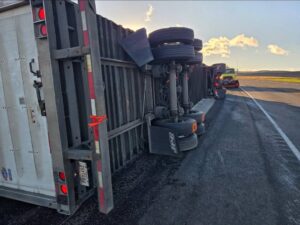DALLAS — Daylight saving time begins Sunday morning, April 10, and with it comes an increased risk of drowsy driving.
Traffic safety experts cite drowsiness as a significant factor in crashes nationwide that kill more than 5,000 people on our roads and highways every year.
The National Road Safety Foundation cautions drivers to be especially aware of driver fatigue as daylight savings begins, since the time change can disrupt normal sleep patterns and lead to drowsiness.
“Drowsy driving can be as dangerous as drinking and driving,” said Michelle Anderson of The National Road Safety Foundation, a non-profit organization that produces and distributes free driver safety education materials.
Drowsy driving is a factor in more than 300,000 crashes every year, causing 109,000 injuries and more than $30 billion in losses, according to the National Highway Traffic Safety Administration.
Studies show nearly two-thirds of motorists have driven while fatigued and more than a third admit to having fallen asleep at the wheel. The Governors Highway Safety Association estimates more than 83 million sleep-deprived Americans are behind the wheel on a typical day.
Sleep experts say the brain may compensate for fatigue by taking micro-sleeps for a few seconds or longer. During a three- or four-second micro-sleep, a person’s eyes may remain open, but the brain is not processing the eyes’ vision signal. A car at highway speed can travel the length of a football field during those few seconds, veering out of its lane and into oncoming traffic or off the road. Sleep-induced crashes often cause very serious injuries, since a dozing driver may not take evasive or corrective action as the vehicle leaves its lane.
Drivers should recognize the signs of drowsiness:
- Difficulty focusing;
- Frequent blinking;
- Not remembering the last few miles driven;
- Head nodding;
- Repeated yawning or rubbing eyes; and
- Drifting out of lane, tailgating or going over rumble strips.
“Some commonly held reliefs for drowsiness, like rolling down the windows or blasting the radio, simply don’t work if you are sleep-deprived,” Anderson said. “The best thing is to find a safe spot to pull over and take a break and, if possible, take a 20-minute nap. Have a cup or two of coffee or a caffeinated snack and allow 30 minutes for the caffeine to enter the bloodstream. Don’t drink alcohol or take medications, which can bring on drowsiness.”
Information about drowsy driving, including a personal “Sleep Diary,” is available at no charge from by clicking here.
WHERE DID DAYLIGHT SAVING TIME COME FROM?
How we came to move the clock forward in the spring, and then push it back in the fall, is a tale that spans over more than a century — one that’s driven by two world wars, mass confusion at times and a human desire to bask in the sun for a long as possible.
There’s been plenty of debate over the practice, but about 70 countries — about 40% of those across the globe — currently use what Americans call daylight saving time.
While springing the clocks forward “kind of jolts our system,” the extra daylight gets people outdoors, exercising and having fun, says Anne Buckle, web editor at timeanddate.com, which features information on time, time zones and astronomy.
“The really, really awesome advantage is the bright evenings, right?” she says. “It is actually having hours of daylight after you come home from work to spend time with your family or activities. And that is wonderful.”
Here are some things to know so you’ll be conversant about the practice of humans changing time:
HOW DID THIS ALL GET STARTED?
In the 1890s, George Vernon Hudson, an astronomer and entomologist in New Zealand, proposed a time shift in the spring and fall to increase the daylight. And in the early 1900s, British home builder William Willett, troubled that people weren’t up enjoying the morning sunlight, made a similar push. But neither proposal gained enough traction to be implemented.
Germany began using daylight saving time during World War I with the thought that it would save energy. Other countries, including the United States, soon followed suit. During World War II, the U.S. once again instituted what was dubbed “war time” nationwide, this time year-round.
In the United States today, every state except Hawaii and Arizona observes daylight saving time. Around the world, Europe, much of Canada and part of Australia also implement it, while Russia and Asia don’t currently.
INCONSISTENCY AND MASS CONFUSION
After World War II, a patchwork of timekeeping emerged across the United States, with some areas keeping daylight saving time and others ditching it.
“You might have one town has daylight saving time, the neighboring town might have daylight saving time but start it and end it on different dates and the third neighboring town might not have it at all,” says David Prerau, author of the book “Seize the Daylight: The Curious and Contentious Story of Daylight Saving Time.”
At one point, if riders on a 35-mile (56-kilometer) bus ride from Steubenville, Ohio, to Moundsville, West Virginia, wanted their watches to be accurate, they’d need to change them seven times as they dipped in and out of daylight saving time, Prerau says.
So in 1966, the U.S. Congress passed the Uniform Time Act, which say states can either implement daylight saving time or not, but it has to be statewide. The act also mandates the day that daylight saving time starts and ends across the country.
Confusion over the time change isn’t just something from the past. In the nation of Lebanon last spring, chaos ensued when the government announced a last-minute decision to delay the start of daylight saving time by a month — until the end of the Muslim holy month of Ramadan. Some institutions made the change and others refused as citizens tried to piece together their schedules. Within days, the decision was reversed.
“It really turned into a huge mess where nobody knew what time it was,” Buckle says.
WHAT WOULD IT BE LIKE IF WE DIDN’T CHANGE THE CLOCKS?
Changing the clocks twice a year leads to a lot of grumbling, and pushes to either use standard time all year, or stick to daylight saving time all year often crop up.
During the 1970s energy crisis, the U.S. started doing daylight saving time all year long, and Americans didn’t like it. With the sun not rising in the winter in some areas till around 9 a.m. or even later, people were waking up in the dark, going to work in the dark and sending their children to school in the dark, Prerau says.
“It became very unpopular very quickly,” Prerau says.
And, he notes, using standard time all year would mean losing that extra hour of daylight for eight months in the evenings in the United States.
A NOD TO THE EARLY ADOPTERS
In 1908, the Canadian city of Thunder Bay — then the two cities of Fort William and Port Arthur — changed from the central time zone to the eastern time zone for the summer and fall after a citizen named John Hewitson argued that would afford an extra hour of daylight to enjoy the outdoors, says Michael deJong, curator/archivist at the Thunder Bay Museum.
The next year, though, Port Arthur stayed on eastern time, while Fort William changed back to central time in the fall, which, predictably, “led to all sorts of confusion,” deJong says.
Today, the city of Thunder Bay is on eastern time, and observes daylight saving time, giving the area, “just delightfully warm, long days to enjoy” in the summer, says Paul Pepe, tourism manager for Thunder Bay Community Economic Development Commission.
The city, located on Lake Superior, is far enough north that the sun sets at around 10 p.m. in the summer, Pepe says, and that helps make up for their cold dark winters. Residents, he says, tend to go on vacations in the winter and stay home in the summer: “I think for a lot of folks here, the long days, the warm summer temperatures, it’s a vacation in your backyard.”
The Associated Press contributed to this report.
Born in Pine Bluff, Arkansas, and raised in East Texas, John Worthen returned to his home state to attend college in 1998 and decided to make his life in The Natural State. Worthen is a 20-year veteran of the journalism industry and has covered just about every topic there is. He has a passion for writing and telling stories. He has worked as a beat reporter and bureau chief for a statewide newspaper and as managing editor of a regional newspaper in Arkansas. Additionally, Worthen has been a prolific freelance journalist for two decades, and has been published in several travel magazines and on travel websites.















